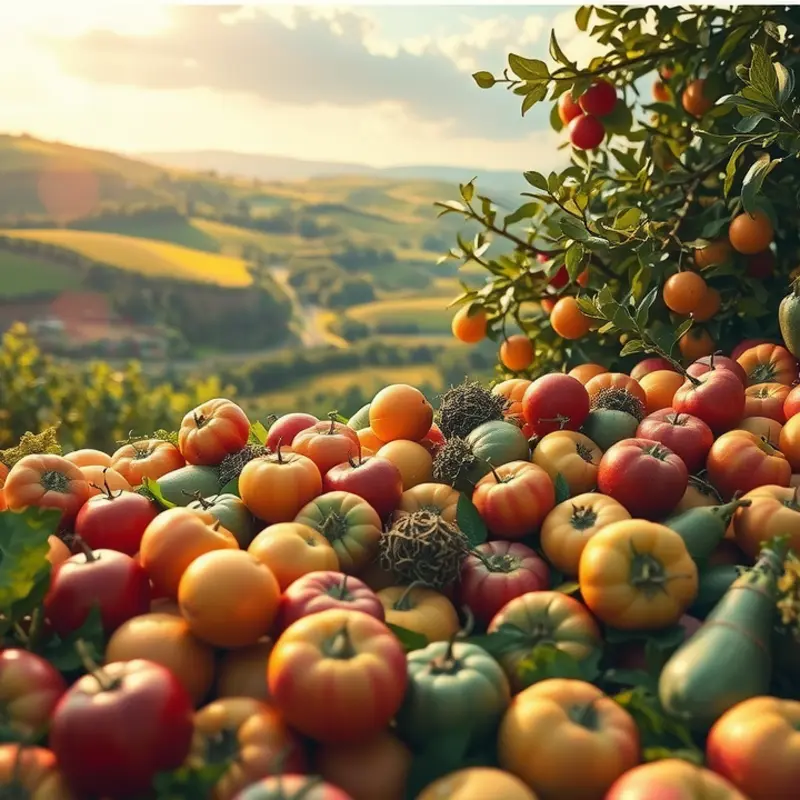Eating healthy doesn’t have to be boring! By incorporating a colorful array of fruits and vegetables into your meals, you can elevate the nutritional value while making your plate visually appealing. Each hue offers unique health benefits, so let’s explore how you can easily enhance your meals with enticing colors.
The Nutritional Rainbow: What Each Color Offers

Eating a colorful variety of fruits and vegetables not only makes your meals more visually appealing, it also boosts nutrition. Each color in the natural spectrum is a signal for different health benefits, a concept often referred to as “eating the rainbow.”
Red: Foods like tomatoes, strawberries, and red bell peppers are rich in powerful antioxidants such as lycopene and anthocyanins. Lycopene, found in tomatoes, is known for its role in heart health and cancer prevention. Strawberries are high in vitamin C, which boosts the immune system and aids in iron absorption.
Green: Green vegetables, including spinach, broccoli, and kale, are a powerhouse of nutrients. They are high in chlorophyll, fiber, and folate. Chlorophyll has detoxifying properties, while folate is crucial for pregnant women as it supports fetal development. Spinach also provides magnesium, important for muscle and nerve function.
Orange: Carrots, sweet potatoes, and pumpkins are notable for their high beta-carotene content. This antioxidant is converted to vitamin A in the body, supporting eye health and vision. Beta-carotene also enhances skin health and immune function. Sweet potatoes provide fiber, aiding digestion.
Yellow: Bananas, corn, and yellow peppers offer a mix of essential nutrients like vitamin C, manganese, and potassium. Potassium is vital for maintaining healthy blood pressure levels. Bananas are an energy-boosting snack due to their natural sugars and carbohydrates.
Blue and Purple: Blueberries, eggplants, and purple grapes are abundant in anthocyanins, a class of antioxidants that combat oxidative stress. This group is particularly beneficial for brain health, potentially improving memory and cognitive function. Blueberries have also been linked to lower risk of heart disease.
Including a variety of colorful foods can ensure a balanced intake of vitamins and minerals. Each hue serves as a visual cue for its nutritional benefits and can encourage us to incorporate diversity in our meals. For further tips on integrating diverse fruits and vegetables into daily diets, check out these Minimal Prep Dinner Ideas.
Simple Ways to Add Color to Your Meals

Infusing color into your meals can be as effortless as it is rewarding. It begins with understanding how to incorporate a variety of fruits and vegetables into your routine. Fortunately, every meal offers a canvas for more color.
Start your day on a vibrant note with a breakfast smoothie bowl. Blend your favorite fruits, such as blueberries, mangoes, and spinach, for a nutrient-dense base. Top it with slices of kiwi, pomegranate seeds, and a sprinkle of chia seeds to add texture and a pop of color. This morning treat is both visually appealing and energetically nourishing.
Lunchtime is another opportunity to brighten your plate. Opt for a mixed grain salad as a base, using quinoa or bulgur. Add roasted sweet potatoes, red bell peppers, and steamed broccoli for a spectrum of colors. A handful of leafy greens and a scattering of cherry tomatoes can make all the difference. Drizzle with a homemade lemon-tahini dressing for an added layer of flavor.
Dinner doesn’t have to be dull, either. Consider a vibrant stir-fry with bell peppers, snap peas, and carrots. The key is to use a high heat to maintain the vegetables’ crispness and color. Serve over jasmine rice or zucchini noodles for an additional infusion of greens, and top with a sprinkle of sesame seeds to finish.
Embrace snacks as another canvas for color. Carrot and cucumber sticks are simple yet colorful choices. Pair them with a beet hummus for a tasty dip that is both striking and nutritious. Alternatively, try preparing a fruit platter with an assortment of berries, grapes, and melons. It’s a feast for the eyes and the palate.
For desserts, think beyond the traditional. A berry compote over yogurt provides a natural sweetness without heavy sugars. Or bake apples with a touch of cinnamon and cranberries for a warming treat. The deep reds and golds create a comforting and inviting appearance.
Integrating these colorful options into your routine not only rejuvenates your meals but also enhances your nutrition profile. A wide variety of colors often indicates a broader range of vitamins and minerals. For more simple, minimal-prep dinner ideas, you can explore resources that focus on integrating colorful veggies into easy meals here. By making these small changes, you set a powerful example of healthy and creative eating while bringing art to your table each day.
Final words
Adding color to your meals is not only visually appealing but also a powerful way to enhance your overall health. By understanding the nutritional benefits of different colors and implementing easy strategies to include a variety of fruits and vegetables in your diet, you can greatly improve your meals. Embrace the rainbow on your plate for better nutrition and enjoyment, starting today!







